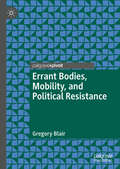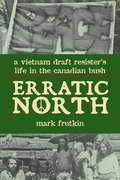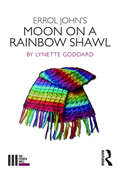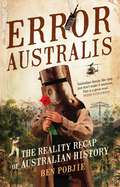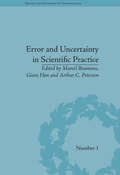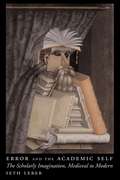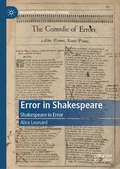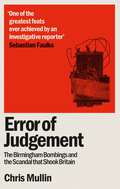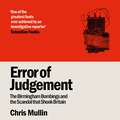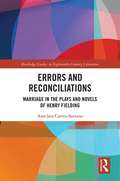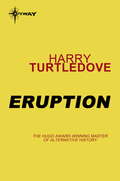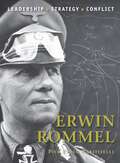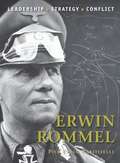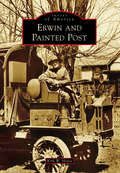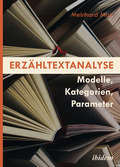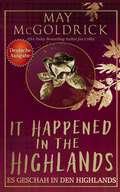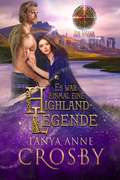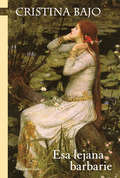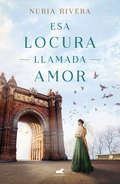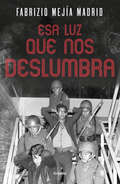- Table View
- List View
Errant Bodies, Mobility, and Political Resistance
by Gregory BlairThis book explores a type of wandering referred to as “errant bodies.” This form of wandering is intentional, without specific destination, and operates as a means of resistance against hegemonic forms of power and cultural prescriptions. Beginning with an examination of the character and particulars of being an errant body, the book investigates historical errant bodies including Ancient Greek Cynics, Punks, Baudelaire, Situationists, Earhart, Kerouac, Fuller, Baudrillard, Hamish Fulton, and Keri Smith. Being an errant body means stepping to the side of dominant culture, creating a potential means of political resistance in the technologically driven twenty-first century.
Erratic North: A Vietnam Draft Resister's Life in the Canadian Bush
by Mark FrutkinIn geology an erratic is a "boulder or rock formation transported some distance from its original source, as by a glacier." In award-winning novelist Mark Frutkin’s case, his movement from his native Cleveland. Ohio, was instigated by his wish to protest and resist the U.S. military draft during the Vietnam War, and his destination was Canada.An estimated 50,000 to 100,000 American Vietnam War draft resisters sought sanctuary in Canada. Many of these men stayed, became Canadian citizens, and have made significant contributions to the country, including writers such as William Gibson, George Fetherling, Keith Maillard, and Jay Scott; musicians Jesse Winchester and Jim Byrnes; children’s performer Eric Nagler; and radio personality Andy Barrie.Although this first nonfiction work by Mark Frutkin looks back at the circumstances and culture of the late 1960s and early 1970s that prompted the author to relocate to Canada, Erratic Northis about many other things. It’s also a lyrical meditation about "returning to nature" in the bush country of Quebec and an account of the crucible that forged one writer. Tying everything together, though, is the overarching theme of the book: a contemplation of humanity’s embrace of war and violence and the countervailing impulse to resist that embrace, specifically as seen in the experience of Frutkin himself; his grandfather Simon, who escaped Tsarist Russia and its military in the 1890s; and Louis Drouin, the Quebec farmer Frutkin bought his original farm from and who resisted conscription in World War II.
Errol John's Moon on a Rainbow Shawl (The Fourth Wall)
by Lynette GoddardErrol John wrote Moon on a Rainbow Shawl (1958) after becoming disillusioned about the lack of good roles for black actors on the British theatre scene. While this situation has only slightly improved since, his response has become the most revived black play in Britain, from its original production at the Royal Court in 1958, to the National Theatre in 2012. It depicts the lives of a black community living in poverty in a shared tenement yard in Port of Spain, Trinidad, in the mid-1940s, showing how each of the characters carries dreams of escaping to create better lives for themselves and their families. Lynette Goddard focuses on how the play articulates the narratives of migration that prompted many Caribbean people to uproot from their homes on the islands and move to the England in the post-war era. For some of them, these dreams of a new life became a reality, but they were experienced differently across genders and generations.
Error Australis: The Reality Recap of Australian History
by Ben PobjieWe're obsessed with reality television these days yet we so often neglect the greatest reality of all: the reality of our nation, and how it came to be. In Error Australis, TV columnist, comedian and history buff Ben Pobjie recaps the history of Australia from its humble beginnings as a small patch of rapidly cooling rock, to its modern-day status as one of the major powers of the sub-Asian super-Antarctic next-to-Africa region. Pobjie recognises that history can be as gripping as any reality show - as thrilling as it is to see Delta Goodrem's chair turn around, there is an argument that the Second World War was even more exciting - and like any good recapper, he provides an immediate, visceral sense of what it was like to be there in the moment at our nation's defining events. All historians know that it is only by looking at where we have been that we can understand who we are, what we stand for, and why nothing seems to work. Error Australis is a scholastic and side-splittingly funny account of a young nation that has spent many years seeking its place in the world, and almost as many years not liking what it has found.
Error Australis: The Reality Recap of Australian History
by Ben PobjieWe're engrossed with reality TV these days, yet we so often neglect the greatest reality of all: the reality of our nation and how it came to be. In Error Australis, TV columnist, comedian and history buff Ben Pobjie recaps the history of Australia from its humble beginnings as a small patch of rapidly cooling rock to its modern-day status as one of the major powers of the sub-Asian super-Antarctic next-to-Africa region. As thrilling as it is to see Delta Goodrem's chair turn around, there's an argument that World War Two was even more exciting and, like any good recapper, Pobjie provides an immediate, visceral sense of what it was like to be there in the moment at our nation's defining events.It is only by looking at where we have been that we can understand who we are, what we stand for and why nothing seems to work. Error Australis is a scholarly and hilarious account of a young nation that has spent many years seeking its place in the world, and almost as many years not liking what it has found.
Error and Uncertainty in Scientific Practice (History and Philosophy of Technoscience #1)
by Marcel Boumans Giora Hon Arthur C. PetersenAssessment of error and uncertainty is a vital component of both natural and social science. This edited volume presents case studies of research practices across a wide spectrum of scientific fields. It compares methodologies and presents the ingredients needed for an overarching framework applicable to all.
Error and the Academic Self: The Scholarly Imagination, Medieval to Modern
by Seth LererHow and why did the academic style of writing, with its emphasis on criticism and correctness, develop? Seth Lerer suggests that the answer lies in medieval and Renaissance philology and, more specifically, in mistakes. For Lerer, erring is not simply being wrong, but being errant, and this book illuminates the wanderings of exiles, émigrés, dissenters, and the socially estranged as they helped form the modern university disciplines of philology and rhetoric, literary criticism, and literary theory. Examining a diverse group that includes Thomas More, Stephen Greenblatt, George Hickes, Seamus Heaney, George Eliot, and Paul de Man, Error and the Academic Self argues that this critical abstraction from society and retreat into ivory towers allowed estranged individuals to gain both a sense of private worth and the public legitimacy of a professional identity.
Error in Shakespeare: Shakespeare in Error (Palgrave Shakespeare Studies)
by Alice LeonardThe traditional view of Shakespeare’s mastery of the English language is alive and well today. This is an effect of the eighteenth-century canonisation of his works, and subsequently Shakespeare has come to be perceived as the owner of the vernacular. These entrenched attitudes prevent us from seeing the actual substance of the text, and the various types of error that it contains and even constitute it. This book argues that we need to attend to error to interpret Shakespeare’s disputed material text, political-dramatic interventions and famous literariness. The consequences of ignoring error are especially significant in the study of Shakespeare, as he mobilises the rebellious, marginal, and digressive potential of error in the creation of literary drama.
Error of Judgement: The Birmingham Bombings and the Scandal That Shook Britain
by Chris Mullin'Very occasionally a journalist starts an avalanche with a single gunshot... Chris Mullin and his TV colleagues belong in the glorious company."-The Observer'One of the greatest feats ever achieved by an investigative reporter'-Sebastian Faulks, the Independent on Sunday'Whoever planted the bombs in Birmingham...also planted a bomb under the British legal establishment'-Robert Harris, Sunday TimesError of Judgment lit a fire under the establishment when it was first published, shattering the prosecution case against six Irishmen charged with the Birmingham Bombings and going on to change the course of British legal history.On the evening of 21st November 1974, bombs planted by the IRA in two crowded Birmingham pubs exploded, killing 21 people and injuring at least 170. Within a day of the explosion, six men - Paddy Hill, Gerry Hunter, Richard McIlkenny, Billy Power, Johnny Walker and Hughie Callaghan - were arrested and charged. All were found guilty.Methodically, with total clarity and a tone that is both gripping and impassioned, then investigative journalist Mullin unpicked every detail of the case, revealing gaping holes in the prosecution case and the horrifying consequences of an establishment determined to close ranks.Now 50 years on from the Birmingham Bombings and with new writing from Mullin, this classic edition of Error of Judgement tells the complete story of one of the most significant miscarriages of justice ever. As relevant now as it was when it was first published, it's an essential text on corruption, violence and bias in British policing and justice.
Error of Judgement: The Birmingham Bombings and the Scandal That Shook Britain
by Chris Mullin'Very occasionally a journalist starts an avalanche with a single gunshot... Chris Mullin and his TV colleagues belong in the glorious company."-The Observer'One of the greatest feats ever achieved by an investigative reporter'-Sebastian Faulks, the Independent on Sunday'Whoever planted the bombs in Birmingham...also planted a bomb under the British legal establishment'-Robert Harris, Sunday TimesError of Judgment lit a fire under the establishment when it was first published, shattering the prosecution case against six Irishmen charged with the Birmingham Bombings and going on to change the course of British legal history.On the evening of 21st November 1974, bombs planted by the IRA in two crowded Birmingham pubs exploded, killing 21 people and injuring at least 170. Within a day of the explosion, six men - Paddy Hill, Gerry Hunter, Richard McIlkenny, Billy Power, Johnny Walker and Hughie Callaghan - were arrested and charged. All were found guilty.Methodically, with total clarity and a tone that is both gripping and impassioned, then investigative journalist Mullin unpicked every detail of the case, revealing gaping holes in the prosecution case and the horrifying consequences of an establishment determined to close ranks.Now 50 years on from the Birmingham Bombings and with new writing from Mullin, this classic edition of Error of Judgement tells the complete story of one of the most significant miscarriages of justice ever. As relevant now as it was when it was first published, it's an essential text on corruption, violence and bias in British policing and justice.
Error of Judgement: The Birmingham Bombings and the Scandal That Shook Britain
by Chris Mullin'Very occasionally a journalist starts an avalanche with a single gunshot... Chris Mullin and his TV colleagues belong in the glorious company."-The Observer'One of the greatest feats ever achieved by an investigative reporter'-Sebastian Faulks, the Independent on Sunday'Whoever planted the bombs in Birmingham...also planted a bomb under the British legal establishment'-Robert Harris, Sunday TimesError of Judgment lit a fire under the establishment when it was first published, shattering the prosecution case against six Irishmen charged with the Birmingham Bombings and going on to change the course of British legal history.On the evening of 21st November 1974, bombs planted by the IRA in two crowded Birmingham pubs exploded, killing 21 people and injuring at least 170. Within a day of the explosion, six men - Paddy Hill, Gerry Hunter, Richard McIlkenny, Billy Power, Johnny Walker and Hughie Callaghan - were arrested and charged. All were found guilty.Methodically, with total clarity and a tone that is both gripping and impassioned, then investigative journalist Mullin unpicked every detail of the case, revealing gaping holes in the prosecution case and the horrifying consequences of an establishment determined to close ranks.Now 50 years on from the Birmingham Bombings and with new writing from Mullin, this classic edition of Error of Judgement tells the complete story of one of the most significant miscarriages of justice ever. As relevant now as it was when it was first published, it's an essential text on corruption, violence and bias in British policing and justice.
Error's Chains: How Forged and Broken, a Complete, Graphic, and Comparative History of the Many Strange Beliefs, Superstitious Practices, Domestic Peculiarities, Sacred Writings, Systems of Philosophy, Legends and Traditions, Customs and Habits of Mankind
by Frank Stockton Dobbins Samuel Wells Williams Isaac Hollister HallEvery nation has its God, or gods, and its corresponding forms of worship. Nothing lies so close to the heart of mankind as its religious faith. Religion in some form is interwoven with the entire fabric of human history. It concerns mans dearest pleasures, his fondest hopes, and his highest aspirations. Man must worship. It is part of his nature to worship. Hence, from the most civilized European to the half-civilized Chinaman, and even down to the degraded Hottentot; in all stages of mans existence, among all races and classes, some form of worship is found. Nothing surely can interest us more than the story of that faith in which our fellow-creatures have lived and died.
Errors and Reconciliations: Marriage in the Plays and Novels of Henry Fielding (Routledge Studies in Eighteenth-Century Literature)
by Anaclara Castro-SantanaHenry Fielding is most well-known for his monumental novel Tom Jones. Though not necessarily common knowledge, Henry Fielding started his literary career as a dramatist and eventually transitioned to writing novels. Though vastly different in their approach and subject, there is a common thread in Fielding’s work that spanned his career: marriage. Errors and Reconciliations: Marriage in the Plays and Novels of Henry Fielding explores this theme, focusing on Fielding’s fascination with matrimony and the ever-present paradoxical nature of marriage in the first half of the eighteenth-century, as a state easily attained but nearly impossible to escape.
Eruption (A\supervolcano Novel Ser.)
by Harry TurtledoveYellowstone National Park sits on a hot spot: a plume of molten rock coming up from deep inside the earth capable of volcanic eruptions far greater than any that have occurred in times past. It has been silent for many years, providing false security for a nation unprepared for the full force and fury of nature unleashed.Then explosions send lava and mud flowing far beyond Yellowstone toward populated areas. Clouds of ash drift across the country, nearly blanketing the land from coast to coast. The fall-out destroys crops and livestock, clogs machinery, and makes cities uninhabitable. Those who survive find themselves facing the dawn of a new ice age as temperatures plummet worldwide.Colin Ferguson is a police lieutenant in a suburb of Los Angeles, where snow is falling for the first time in decades. He fears for his family, who are spread across America, refugees caught in an apocalyptic catastrophe in which humanity has no choice but to rise from the ashes and re-create the world...
Erwin Rommel
by Peter Dennis Pier BattistelliNicknamed 'The Desert Fox' for his cunning command of the Afrika Korps, Erwin Rommel remains one of the most popular and studied of Germany's World War II commanders. He got his first taste of combat in World War I, where his daring command earned him the Blue Max, Germany's highest decoration for bravery. He followed this up with numerous successes early in World War II in both Europe and Africa, before facing his biggest challenge - organizing the defence of France. Implicated in the plot to kill Hitler, Rommel chose suicide over a public trial. This book looks at the life of this daring soldier, focusing on his style of command and the tactical decisions that earned him his fearsome reputation.
Erwin Rommel: Leadership, Strategy, Conflict
by Pier Paolo BattistelliA short biography of General field marshal Erwin Rommel, the legendary 'Desert Fox', who ranks amongst the most famous generals of World War II. A daring infantry officer during World War I, in the early months of World War II Rommel took over command of a Panzer division, which he led in one of the most crucial areas of the German offensive in the West. It was as commander of the Afrikakorps from 1941 that he fought his most famous battles and came close to driving the British out of Egypt. Defeated by Montgomery at El Alamein, he later led the German forces during the battle for Normandy in 1944, but after being implicated in the plot against Hitler, he was forced to commit suicide. Lionized by British historians of the post-war period as representing all that was good in the German military tradition, this title re-assesses his role as a battlefield commander, analysing his strengths and weaknesses.
Erwin and Painted Post
by Kirk W. HouseErwin and Painted Post are home to major facilities of Corning, Inc., formerly known as Corning Glass Works, a company that made a powerful impact on Erwin's history. In Erwin, folks poured steel, tried out the exotic 1920s military vehicle seen on the cover, and attended family Christmas parties at Ingersoll-Rand. Many of these photographs come from before those high-tech and heavy-industry days, when men rafted lumber down to Gang Mills and farmers relied on equipment that required more horses than men. Over 200 years, Painted Post folks erected four figures of Native Americans. They all still exist and are captured in images here, as are Painted Post High School, the Townsend's Grove Post Office, the Erwin family's fine homes, and life in Cooper's Plains, both then and now. A century and a half of railroading and a century of floods--including the catastrophic Hurricane Agnes in 1972--have altered the landscape. Images of Colonial Days, drill teams, old-time grocery stores, Costa's Field, and even the Civilian Conservation Corps recall a bygone time in local history.
Erzähltextanalyse [German-language Edition]: Modelle, Kategorien, Parameter
by Meinhard MairThis comprehensive and systematic text book provides teachers and students alike with a profound, yet concise reference for the analysis of narrative texts. It provides appropriate and differentiated terminological and methodological tools to all the questions that arise when analyzing a narrative text. An advantage of this textbook is that the narrative theory models and concepts are presented in understandable and operational analytical categories and parameters and illustrated by tables and matrices to help make the sophisticated analysis easier to understand and memorize. Exemplary model analyses are provided to present and test the performance of this method.This book is valuable not only to literary scholars but is also suitable to teachers and students.Lehrende und Studierende, die einen Erzähltext analysieren wollen, finden in diesem umfassenden, systematischen, profunden und zugleich übersichtlichen Lehrbuch und Nachschlagewerk ein geeignetes und differenziertes terminologisches und methodisches Instrumentarium, um alle Fragen, die bei der Analyse eines Erzähltextes auftauchen, beantworten zu können. Ein Vorzug des vorliegenden Handbuches besteht darin, dass die erzähltheoretischen Modelle und Konzepte in verständliche und operative analytische Kategorien und Parameter umgesetzt und durch Tabellen, Matrizen und graphische Darstellung veranschaulicht werden, um die anspruchsvollen analytischen Raster besser fass- und memorierbar zu machen. In exemplarischen Musteranalysen wird die Leistungsfähigkeit der vorliegenden Erzähltextanalyse erprobt. Das Buch wendet sich nicht nur an Literaturwissenschaftler, sondern ist auch für Lehrkräfte und Schüler geeignet
Es Geschah in den Highlands: SERIE DER FAMILIE PENNINGTON (SERIE DER FAMILIE PENNINGTON)
by Jan Coffey May McGoldrickJILTED BRIDE... EIN DUELL BEI TAGESANBRUCH... EIN LANGE GEHÜTETES GEHEIMNIS... EINE ZWEITE CHANCE FÜR DIE LIEBE... Lady Josephine Pennington wurde von ihrem Verlobten sitzen gelassen, als Gerüchte über ihre fragwürdige Herkunft aufkamen. Ihre Adoptiveltern haben ihr immer die Liebe und den Schutz gegeben, die sie brauchte, um sich sicher zu fühlen, und in den letzten sechzehn Jahren hat sie sich so geformt, dass sie die Erwartungen anderer erfüllt. Als sie ein Paket aus den Highlands erhält, das Skizzen enthält, deren Motive ihr unheimlich vertraut sind, glaubt Jo, einen Hinweis auf die Identität ihrer leiblichen Mutter gefunden zu haben. Als Captain Wynne Melfort vor sechzehn Jahren seine Verlobung mit Jo Pennington löste, hätte er nie gedacht, dass er sie wiedersehen würde. Doch als er Informationen entdeckt, die die Wahrheit über Jo's Abstammung enthüllen könnten, fühlt sich Wynne verpflichtet, ein altes Unrecht wiedergutzumachen und sie über seinen Fund zu informieren. Aber er hätte nie erwartet, dass längst tot geglaubte Gefühle wieder aufflammen würden. Jo muss lernen, Wynn zu vertrauen, während sie sich bemühen, das Geheimnis ihrer Geburt zu lüften. Doch es tauchen Kräfte auf, die vor nichts zurückschrecken, um sie daran zu hindern, die Wahrheit aufzudecken und ihr Erbe zurückzuerobern. Gemeinsam müssen sie und Wynne ihre Vergangenheit überwinden und eine tödliche Bedrohung bekämpfen, die tief in den Nebeln der Highlands lauert.
Es cuento largo
by Günter GrassAlemania entre la caída del Muro y la Unificación, entre el júbilo y la resaca, desde el punto de vista de Günter Grass. Una obra maestra, un punto de vista insólito e irritante para muchos. Diciembre hiela, y el Muro está cayendo. Dos viejos (uno alto y enjuto, otro pequeño y rechoncho; uno de pasos largos, bastón y bufanda al viento, otro de pasitos cortos, con una cartera repleta de documentos) se acercan a la Potsdamer Platz, atraviesan la abierta frontera y doblan a la derecha, camino de la Puerta de Brandeburgo, a lo largo del Muro... Dos viejos que tienen cosas en común: sus recuerdos se remontan muy lejos en el tiempo, ambos viven según el modelo de sus predecesores y tienen el pasado tan presente y actual como la vida de todos los días... Un panorama profundamente literario de la historia alemana, desde la Revolución de marzo de 1848 hasta nuestros días. Una demostración de que el tiempo está dentro del tiempo, una deslumbrante muestra de talento literario y percepción del mundo. En pocas palabras: una novela magistral de Günter Grass.
Es war einmal eine Highland-Legende
by Tanya Anne Crosby Michaela Bittner und Christina LöwEine romantische Zeitreise in den schottischen Highlands Im Jahr 2014 treffen wir Annie Ross, die sich ihr ganzes Leben lang ein wenig verloren gefühlt hat. Bald wird sie sich auch noch in einer anderen Zeit wiederfinden - im Jahr 878 n. Chr. Dort muss sie ihren Platz als Hüterin des Schicksalssteins einnehmen und eine Möglichkeit finden, den Glauben eines mächtigen Highland-Chiefs wiederherzustellen. Wird sie dabei auch Callums Herz gewinnen? Tanya Anne Crosby kehrt zu den Ursprüngen der Legende selbst zurück - in eine Zeit, in der Magie noch einen Platz hatte und die Pikten kurz davorstanden, aus der Geschichte der Highlands zu verschwinden.
Esa lejana barbarie
by Cristina BajoEsa lejana barbarie anuda con maestría los hilos de la vida de todos los personajes de la saga de los Osorio que seguimos a lo largo de treinta años. Buenos Aires, Londres, París, Florencia y Córdoba son los escenarios de esta historia. Entre estas ciudades, el lector recuperará la suerte de los que residen en el país y aquellos que quedaron en Europa. La noticia del fusilamiento de Camila O'Gorman y Ladislao Gutiérrez, por órdenes de Juan Manuel de Rosas, se extendió por todo el país, marcando el principio del fin de una época. Por aquellos tiempos, los Osorio, atrapados por la guerra civil, no habían quedado al margen de la violencia, de los desarraigos -voluntarios o forzosos-, del dolor que los ha unido en espíritu aunque los haya separado materialmente. Y desde este o el otro lado del océano, ninguno permanecerá ajeno a la esperanza que propone el general Urquiza: protagonistas de la historia, esperan superar los desencuentros y reconstruir una existencia que saque al país de la barbarie y permita la unificación de las provincias. Cristina Bajo es la mejor escritora Argentina de este siglo. Sus contemporáneos tenemos la dicha de poder celebrar el surgimiento de sus obras como todos aquellos que se jactan de haber sido testigos de grandes momentos históricos. Los Osorio, excediendo el término de la saga, seguirán viviendo en la imaginación de los lectores más allá de la palabra. «Nadie novela la historia con la maestría de Cristina Bajo. Esa lejana barbarie es el broche de oro para una de las mejores sagas que he leído» Florencia Bonelli «Leer a Cristina Bajo es leer a una leyenda literaria contemporánea: erudita y ágil al mismo tiempo, en su saga de los Osorio, que comenzó con la extraordinaria Como vivido cien veces, logra personajes inolvidables en el marco de la guerra civil y de la provincia de Córdoba, que es un personaje más en su literatura. Es imposible abandonar estos libros inteligentes, deliciosos y, cuando es necesario, brutales.» Mariana Enriquez
Esa locura llamada amor
by Nuria RiveraEsa locura llamada amor es la historia de un beso, de una pasión y de cómo a veces el amor se convierte en locura. La Barcelona de la Exposición Universal de 1888 será testigo del amor entre un médico y una modista. Una pasión que cuenta la historia de un beso. Gonzalo Losada provoca la ira de su padre cuando decide abandonar su puesto de cirujano para especializarse como médico de enfermedades mentales en otra ciudad, con el mejor neurólogo del momento. Inés Ribas, hija de un empresario textil catalán, tiene el sueño de convertirse en diseñadora de modas. Su padre, que la consiente en todo, solo le pondrá una condición. El destino es caprichoso y coloca a Inés en el camino de Gonzalo. Este queda prendado de ella nada más verla y busca un acercamiento, pero no sabe que la modista lo utilizará para ganar un reto. Tiempo después coinciden en una fiesta y ninguno de los dos ha olvidado su fugaz encuentro. Atrapados por la pasión que desborda sus corazones, se hacen promesas de amor, pero la vida los empuja por caminos separados hasta que vuelven a encontrarse. Ambos han cambiado. Los malentendidos, el rencor y los celos, la familia y la traición se interponen entre ellos. Gonzalo descubrirá que tiene en su poder la llave para ser feliz o perder a Inés para siempre.
Esa luz que nos deslumbra
by Fabrizio Mejía MadridLa novela definitiva sobre la colisión ideológica del 2 de octubre de 1968. A lo largo de medio siglo, el 68 mexicano ha dejado a su paso una gran variedad de libros testimoniales, análisis políticos y memorias personales que aspiran a esclarecer los hechos que ocurrieron la fatídica noche del 2 de octubre en Tlatelolco. Pero hasta ahora ninguno había conjuntado todas las voces en un mismo relato. Esa luz que nos deslumbra es la historia del choque entre el autoritarismo del Partido Único y la diversidad, la alegría y la esperanza de los universitarios. De esa colisión emergió la tragedia que no se olvida, pero también los gérmenes de un mito cívico que ha perdurado por más de dos generaciones. La novela transcurre desde los preparativos oficiales para la inauguración de los Juegos Olímpicos de México 68 hasta la matanza del Jueves de Corpus en 1971 y los finales trágicos de algunos de los líderes y represores del movimiento estudiantil. Pero no se detiene ahí. También se adentra en las discusiones y dilemas que estudiantes y gobierno tuvieron para resolver el conflicto, y nos presenta a las personas que sorprendentemente jamás advirtieron la magnitud y el significado de las protestas y que apoyaron, con su silencio, la brutal represión. Sólo una cosa queda en claro: el fantasma de estos sucesos nos persigue hasta nuestros días, convertido en la pregunta que atormenta a unos y otros: ¿quién es culpable de la Historia?
